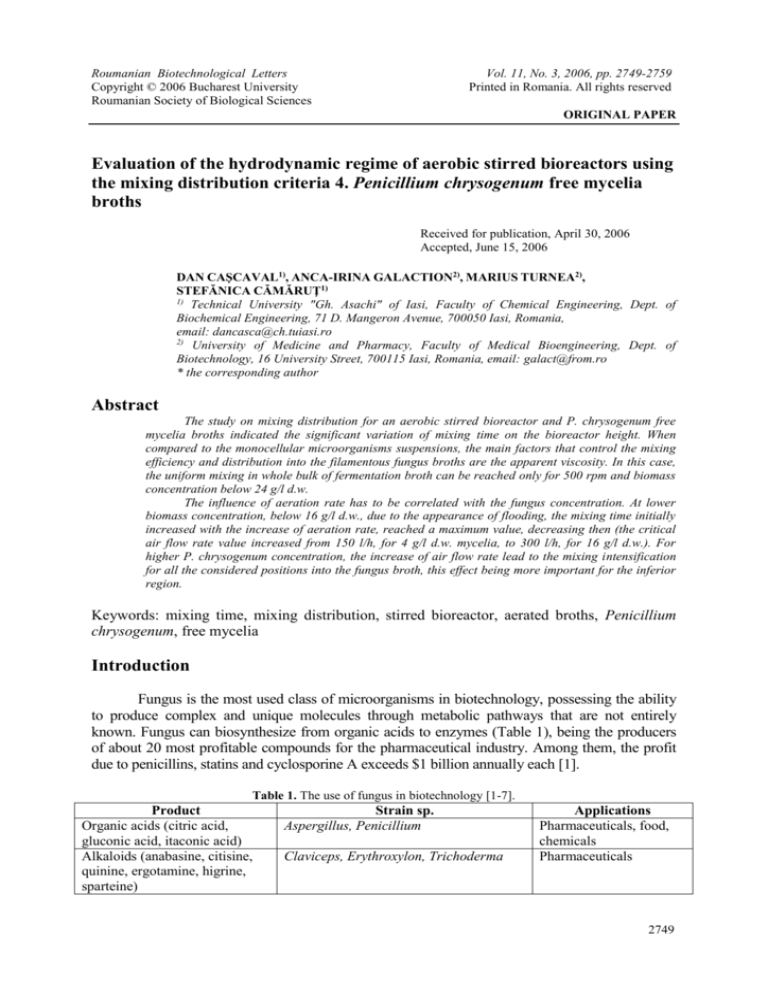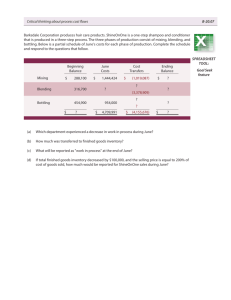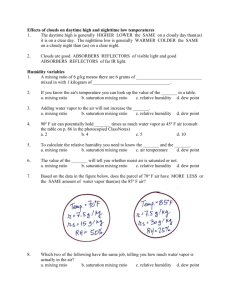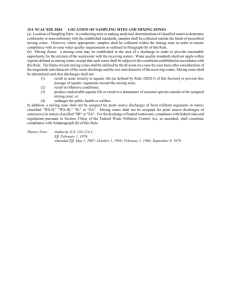
Roumanian Biotechnological Letters
Copyright © 2006 Bucharest University
Roumanian Society of Biological Sciences
Vol. 11, No. 3, 2006, pp. 2749-2759
Printed in Romania. All rights reserved
ORIGINAL PAPER
Evaluation of the hydrodynamic regime of aerobic stirred bioreactors using
the mixing distribution criteria 4. Penicillium chrysogenum free mycelia
broths
Received for publication, April 30, 2006
Accepted, June 15, 2006
DAN CAŞCAVAL1), ANCA-IRINA GALACTION2), MARIUS TURNEA2),
STEFĂNICA CĂMĂRUŢ1)
1)
Technical University "Gh. Asachi" of Iasi, Faculty of Chemical Engineering, Dept. of
Biochemical Engineering, 71 D. Mangeron Avenue, 700050 Iasi, Romania,
email: dancasca@ch.tuiasi.ro
2)
University of Medicine and Pharmacy, Faculty of Medical Bioengineering, Dept. of
Biotechnology, 16 University Street, 700115 Iasi, Romania, email: galact@from.ro
* the corresponding author
Abstract
The study on mixing distribution for an aerobic stirred bioreactor and P. chrysogenum free
mycelia broths indicated the significant variation of mixing time on the bioreactor height. When
compared to the monocellular microorganisms suspensions, the main factors that control the mixing
efficiency and distribution into the filamentous fungus broths are the apparent viscosity. In this case,
the uniform mixing in whole bulk of fermentation broth can be reached only for 500 rpm and biomass
concentration below 24 g/l d.w.
The influence of aeration rate has to be correlated with the fungus concentration. At lower
biomass concentration, below 16 g/l d.w., due to the appearance of flooding, the mixing time initially
increased with the increase of aeration rate, reached a maximum value, decreasing then (the critical
air flow rate value increased from 150 l/h, for 4 g/l d.w. mycelia, to 300 l/h, for 16 g/l d.w.). For
higher P. chrysogenum concentration, the increase of air flow rate lead to the mixing intensification
for all the considered positions into the fungus broth, this effect being more important for the inferior
region.
Keywords: mixing time, mixing distribution, stirred bioreactor, aerated broths, Penicillium
chrysogenum, free mycelia
Introduction
Fungus is the most used class of microorganisms in biotechnology, possessing the ability
to produce complex and unique molecules through metabolic pathways that are not entirely
known. Fungus can biosynthesize from organic acids to enzymes (Table 1), being the producers
of about 20 most profitable compounds for the pharmaceutical industry. Among them, the profit
due to penicillins, statins and cyclosporine A exceeds $1 billion annually each [1].
Table 1. The use of fungus in biotechnology [1-7].
Product
Organic acids (citric acid,
gluconic acid, itaconic acid)
Alkaloids (anabasine, citisine,
quinine, ergotamine, higrine,
sparteine)
Strain sp.
Aspergillus, Penicillium
Claviceps, Erythroxylon, Trichoderma
Applications
Pharmaceuticals, food,
chemicals
Pharmaceuticals
2749
DAN CAŞCAVAL, ANCA-IRINA GALACTION, MARIUS TURNEA, STEFĂNICA CĂMĂRUŢ
Antibiotics (penicillins,
cephalosporins, griseofulvin,
fumagillin)
Enzymes (asparaginase,
amylase, catalase, cellulase,
dextranase, -glucanase,
glucose oxidase, hemicellulase,
lipase, pectinase, protease,
tannase, xylanase)
Phytohormones (abscisic acid,
gibberellic acid)
Immunomodulators,
immunosuppressants
(cyclosporine A, mevinolin,
polysaccharides)
Pigments (antraquinones)
Polysaccharides (-glucan,
lentinan, chitosan, chitin)
Statins (lovastatin, simvastatin,
pravastatin)
Steroids
Toxins (mycoinsecticides,
mycoherbicides: patulin,
aflatoxins, ochratoxin,
fumonisin)
Vitamins (vitamin B group,
vitamin D)
Acremonium, Aspergillus,
Cephalosporium, Cordyceps, Penicillium
Pharmaceuticals
Aspergillus, Endothia, Mucor,
Penicillium, Phanerochaete, Pyricularia,
Trametes, Trichoderma
Pharmaceuticals, food,
chemicals, detergents
Cercospora, Fusarium, Gibberella
Agriculture, horticulture
Cordyceps, Cylindrocarpon, Lentinula,
Monascus, Tolypocladium, Trichoderma
Pharmaceuticals
Aspergillus, Curvularia, Drechslera,
Trichoderma
Lentinula
Textile dyes, cosmetics
Aspergillus, Penicillium
Achlya, Fomitopsis
Agaricus, Amanita, Aspergillus,
Coprinus, Cortinarius, Fusarium,
Gyomitra, Metharizium, Penicillium,
Psylocybe
Eremothecium, Nematospora, Pleurotus
Cosmetics,
pharmaceuticals, food
Pharmaceuticals
Pharmaceuticals
Agriculture, horticulture
Pharmaceuticals, food,
cosmetics
The use of the fungus in biotechnology requires their strains isolation, the increase of their
activity by genetically techniques, as well as their cultivation on specific media for
biosynthesizing of the desired products. The fermentation conditions exhibit a decisive influence
on fungus growth and biosynthesis. The deviation from the optimum parameters could involve the
significant alteration of fungus activity, morphology or biosynthetic compounds structures. For
example, the modification of some media components concentration (polyelectrolytes, carbon
dioxide) or of the aeration/mixing intensity could lead to the modification of mycelia aggregates
size or of the formation of filamentous mycelia, with important influences on broths rheology or
viscosity, on rate of heat and mass transfer [8].
The capacity of bioreactor to ensure the reduction of the temperature and
concentration gradients inside the broths represents one of the most important conditions for
an optimum fermentation process. From the viewpoint of the difficulty to reach the optimum
hydrodynamic regime in the bioreactor, the exploitation of fungus cultures is the most
complicate, on the one hand due to their higher apparent viscosity, and on the other hand due
to their complex rheological behavior.
The establishing of the optimum hydrodynamic regime, the selection of the stirrer type
that has to be used, or the prediction of the modification of mixing efficiency by scaling-up
can be made by analyzing the mixing distribution into the bioreactor. This analysis becomes
more important in the case of fungus broths, owing to their major influence on mixing
efficiency compared with bacteria, yeasts or actinomicetes. The complexity of fungus broths
rheology and their high apparent viscosity induce a non-uniform distribution of mixing
2750
Roum. Biotechnol. Lett., Vol. 11, No. 3, 2749-2759 (2006)
Evaluation of the hydrodynamic regime of aerobic stirred bioreactors using the mixing distribution criteria 4.
Penicillium chrysogenum free mycelia broths
intensity, with the inevitable appearance of the heterogeneous regions. Furthermore, because
the most of the fungus fermentations are aerobic, the flow mechanism becomes more
complicated due to the cumulated effects of the pneumatic and mechanical mixing. The
aeration generates flow streams that are significant different from those induced by
mechanical mixing into the non-aerated broths.
For establishing the mixing distribution and identifying the stagnant regions inside the
broths, the values of mixing time must to be analyzed at different positions into the
bioreactor. In this purpose, it is more appropriate to maintain the feed position of the tracer
and to modify the position of the electrode used for mixing time determination [9].
Generally, the analysis of mixing efficiency for the aerated mechanical stirred systems
is derived from that of non-aerated systems, due to the less complicated flow phenomena for
the second ones. Because it has been assumed that the bubbles don’t influence the broths
flow, the values of mixing time calculated for aerated broths by means of the equations
established for non-aerated systems differ significantly from the experimental ones (in most
of these cases, the values of calculated mixing time were lower for about 1.2 - 2 times than
the experimental data [10]). In this context, the aeration influence on mixing efficiency and
distribution in bioreactors is complex and has to be distinctly analyzed. In most aerobic
fermentations, the air is accumulated around the stirrers with the formation of cavities or
compartmentalization of flow regions, that reducing the pumping capacity of the stirrer and
modifying the distribution of mixing intensity compared with the non-aerated systems
[11,12].
Therefore, the aim of our studies is to establish the distribution of mixing efficiency
inside the aerobic stirred bioreactor, by means of the mixing time values obtained at various
positions of pH-electrode, as well as the influences of the broths characteristics and operating
parameters on the change of active and stagnant regions positions. For underlining the effect
of the biomass presence and morphology on mixing efficiency, the experiments have been
carried out for aerated broths without and with microorganisms (bacteria, yeasts, fungus).
Because the morphological conformation of the microorganisms contributes significantly to
the broths rheological behavior, in this paper the previous experiments on mixing distribution
for aerated P. chrysogenum pellets cultures are continued and developed for free mycelia
cultures.
Materials and method
The experiments have been carried out in 5 l (4 l working volume, ellipsoidal bottom)
laboratory bioreactor (Biostat A, B. Braun Biotech International), with computer-controlled
and recorded parameters. The bioreactor characteristics and operating parameters have been
presented in the previous papers [14].
The mixing system consists on a double stirrer and three baffles. The impeller
diameter, d, was of 64 mm. The inferior stirrer has been placed at 64 mm from the bioreactor
bottom. The superior stirrer was placed on the shaft at a distance of 64 mm (d) from the
inferior one, this being the optimum distance for the Ruston turbine, as it was demonstrated in
the previous works on P. chrysogenum broths [145]. The rotation speed was maintained
below 500 rpm. The experiments have been carried out at Reynolds number lower than 6,800,
domain that avoids the cavity formation at the broths surface.
The sparging system consists of a single ring sparger with 64 mm diameter, placed at
15 mm from the vessel bottom, having 14 holes with 1 mm diameter. The air volumetric flow
Roum. Biotechnol. Lett., Vol. 11, No. 3, 2749-2759 (2006)
2751
DAN CAŞCAVAL, ANCA-IRINA GALACTION, MARIUS TURNEA, STEFĂNICA CĂMĂRUŢ
rate was varied from 75 to 450 l/h, corresponding to an air superficial velocity of 0.84 5.02x10-3 m/s.
The P. chrysogenum free mycelia suspensions having biomass concentration between
4 and 36 g/l d.w. have been used. The experiments were carried out at a temperature of 24oC.
Any morphological conformation change was recorded during the experiments.
The mixing efficiency has been analyzed by means of the mixing time values. The
experimental measurement of mixing time uses the tracers (acidic, alkaline or salts solutions,
heated solutions, colored solutions) which are added to the beforehand homogenized broths.
The mixing time is the time needed for the considered parameter (pH-value, temperature,
absorption etc.) to reach a constant value. Because the perfect mixing can be reached after a
long period, for the mixing time determination a predefined level of homogeneity is admitted
[10,15].
For mixing time determination, a solution of 2N KOH has been used as tracer, being
recorded the time needed to the medium pH-value to reach the value corresponding to the
considered mixing intensity. In this case, the following homogeneity criteria for mixing have
been considered:
I
pH 0.5pH
x100 99%
pH
where pH = 0.02.
The tracer volume was of 0.5 ml, the tracer being injected opposite to the pH
electrode, at 65 mm from the stirrer shaft and 10 mm from the liquid surface. Because the
tracer solution density is close to the liquid phase density, the tracer solution flow follows the
liquid flow streams and there are no errors due to tracer buoyancy.
The pH electrode was placed at the four different positions mentioned in the previous
papers [9]. The pH variations were recorded by the bioreactor computer-recorded system and
were analyzed for mixing time calculation.
Results and discussion
Unlike the bacteria and yeasts, the fungus can grow on two morphological
conformations: free mycelia and mycelia aggregates (pellets). Moreover, indifferent of the
morphological structure, the accumulation of fungus biomass induces a significant increase of
broths viscosity, that controlling the suspension rheology, but the magnitude of this influence
depends on the fungus morphology [8]. Thus, for P. chrysogenum strains used in these
experiments, the apparent viscosity of suspension was of 172.5 cP for free mycelia and 88.4
cP for pellets, at a biomass concentration of 33.5 g/l d.w. [14]. These differences are
recovered in the values of mixing time corresponding to the two morphological structures and
are either the result of the stronger hyphal-hyphal interactions for filamentous conformation,
or of the deposition tendency for pellets. Thus, the biomass morphology correlated with the
biomass concentration determines the rheological behavior and properties of fungus
suspensions and, consequently, the mixing intensity.
The previous studies on the influence of operating conditions on mixing efficiency of
non-aerated P. chrysogenum free mycelia broths in stirred bioreactors indicated that the
mixing intensity continuously increased with the impeller rotation speed, being considerably
lower than that obtained for the cultures of bacteria or yeasts [14].
Compared with the non-aerated fermentation systems, in the case of aerobic stirred
bioreactors provided with single or multiple impellers the broths flow becomes more complex
due to the cumulated pneumatic and mechanical agitation. The deviations from the obtained
values for non-aerated broths depend on the constructive and operating characteristics of the
bioreactor, as well as on the microorganisms morphology. For aerated cultures of P.
2752
Roum. Biotechnol. Lett., Vol. 11, No. 3, 2749-2759 (2006)
Evaluation of the hydrodynamic regime of aerobic stirred bioreactors using the mixing distribution criteria 4.
Penicillium chrysogenum free mycelia broths
chrysogenum free mycelia, the mixing was initially intensified by increasing the rotation
speed, decreasing then [15]. The critical rotation speed, which corresponds to the minimum
level of mixing time, was between 400 and 500 rpm, depending on biomass concentration.
The existence of minimum mixing time for fungus broths was more evidently compared with
the bacteria or yeasts suspensions, due to the higher viscosity of fungus broths [14].
The aeration rate influence is correlated with the fungus concentration. Therefore, at
constant rotation speed, the previous experiments underlined that at lower biomass
concentration (4 g/l d.w.) the intensification of aeration initially induced the increase of
mixing time to a maximum value, followed by its decrease. This variation is due to the
appearance of the flooding for the air flow rate of 150 - 200 l/h [15]. In the case of more
concentrated P. chrysogenum broths (30 g/l d.w.), the aeration effect was contrary to the
above presented one, the increase of aeration leading to the continuous intensification of
broths circulation. This phenomenon that was more accentuated for free mycelia suspension
than for pellets one, due to the higher viscosity of the former [15].
The previous results have been obtained for position 1 of the pH electrode. But, by
placing the pH electrode in different regions inside the bioreactor it could be drawn more
rigorous conclusions concerning the distribution of mixing intensity, as well as on the effects
of broths characteristics (concentration, morphology) and/or fermentation conditions on
mixing efficiency in a given region inside the bioreactor. This approach leads to the recording
of the mixing intensity variations in whole bulk of the broth, which could differ significantly
from the above presented for aerated P. chrysogenum suspensions.
At a constant aeration level, from Figure 1 it can be observed that the shape of the
obtained curves is similar for fungus concentration up to 24 g/l d.w. Thus, the mixing time
initially decreases to a minimum value, increasing then with the increase of rotation speed.
This variation is the result of the change in relative importance of mechanical and pneumatic
mixing. At lower rotation speed, the contribution of pneumatic mixing is more important,
especially in the regions placed there away from the impellers. In this case, the increase of
rotation speed intensifies the mixing. At higher value of rotation speed, the gas hold-up
increases, the flow of dispersion becomes more complex and its circulation velocity is inferior
to that induced by the mechanical agitation in non-aerated systems. Moreover, the increase of
rotation speed induces the dispersion of biomass into the whole bulk of the broth, respectively
in the regions 2, 3 and 4, therefore the values of mixing time recorded for these regions
become closer. The critical rotation speed, corresponding to the minimum of mixing time
[16], is 400 rpm.
CX = 4 g/l d.w.
tm, s
Position 1
Position 2
Position 3
Position 4
120
Position 1
Position 2
Position 3
Position 4
160
tm, s
140
CX = 16 g/l d.w.
140
100
120
80
100
60
200
300
400
500
Rotation speed, rpm
80
200
Roum. Biotechnol. Lett., Vol. 11, No. 3, 2749-2759 (2006)
300
400
500
Rotation speed, rpm
2753
DAN CAŞCAVAL, ANCA-IRINA GALACTION, MARIUS TURNEA, STEFĂNICA CĂMĂRUŢ
CX = 24 g/l d.w.
CX = 30 g/l d.w.
tm,s
250
300
Position 1
Position 2
Position 3
Position 4
tm, s
Position 1
Position 2
Position 3
Position 4
225
270
200
240
175
150
210
125
180
100
200
300
200
400
500
Rotation speed, rpm
300
400
500
Rotation speed, rpm
CX = 36 g/l d.w.
440
tm, s
Position 1
Position 2
Position 3
Position 4
400
360
320
280
200
300
400
500
Rotation speed, rpm
Figure 1. Influence of rotation speed on mixing time (aeration rate of 75 l/h).
The P. chrysogenum accumulation induces the reduction of the mixing intensity in
whole bulk of the fermentation broth, this effect being more pronounced for the superior
regions, due to their position related to the impellers (for 400 rpm, by increasing the fungus
concentration from 4 to 36 g/l d.w., the mixing time increased for 3.7 times for position 1,
respectively for 5.6 times for position 4; the difference between the two positions is less
important than that previously recorded for pellets suspensions in the same experimental
conditions, due to the superior deposition tendency of pellets, this amplifying the
heterogeneity of the system [13]).
Because in the vase of free mycelia cultures the biomass is more uniform distributed
into the broths, the position of the impellers controls the mixing distribution for a given level
of fungus concentration. Therefore, it can be observed that by increasing the fungus
concentration, respectively by increasing the apparent viscosity, the variations of mixing time
plotted in Figure 1 are changed, the rotation speed influence becoming more pronounced for
the inferior positions 1 and 2. For this reason, for rotation speed over 350 - 400 rpm and
biomass concentration higher than 30 g/l d.w., the mixing intensity is superior in the positions
1 and 2, these results being opposite to those obtained for pellets suspensions [13].
According to what was mentioned above, the analysis of the mixing distribution for
the four considered positions into the bioreactor indicated that the lowest mixing time values
2754
Roum. Biotechnol. Lett., Vol. 11, No. 3, 2749-2759 (2006)
Evaluation of the hydrodynamic regime of aerobic stirred bioreactors using the mixing distribution criteria 4.
Penicillium chrysogenum free mycelia broths
have been recorded for the inferior region only for fungus concentration below 24 g/l d.w. and
rotation speed below 400 rpm (Figure 2). If these limits are exceeded, the most efficiently
mixed regions become those corresponding to the positions 1 and 2 of the pH electrode.
By comparing these results to those obtained for simulated broths without biomass, for
which the highest values of mixing time have been obtained for the intermediary positions 2
and 3, due to the interference of the flow streams generated by the impellers [9], or with those
for pellets cultures, for which the most inefficient mixing have been reached at positions 1
and 2, due to the biomass deposition [13], it can be underlined the decisive influence of solid
phase presence and morphology on broth circulation and mixing distribution inside the
bioreactor.
Similar to the P. chrysogenum pellets broths, for biomass concentration up to 24 g/l
d.w., Figure 2 suggests the existence of an optimum rotation speed of 500 rpm which
corresponds to the uniform mixing into the whole bulk of free mycelia broth. The
accumulation of biomass over the above mentioned level induces the heterogeneous
distribution of mixing, effect that becomes more accentuated at higher fungus concentration
(36 g/l d.w.).
These results differ from those obtained for other aerated microorganisms cultures.
For example, for S. cerevisiae broths it can be reached a uniform dispersion of the cells also at
high biomass concentration (150 g/l d.w.). In this case, the value of the optimum rotation
speed increased from 300 rpm for yeasts concentration below 75 g/l d.w. to 500 rpm for
suspensions more concentrated than 130 g/l d.w. [17]. The observed differences are the
consequence of the significant higher viscosity of fungus broths, even at low biomass
concentration, thus reducing the mixing efficiency and amplifying the system heterogeneity
(the apparent viscosity of the P. chrysogenum free mycelia suspension of 33.5 g/l d.w. is
172.5 cP [14], compared with 7 cP of the S. cerevisiae suspension of 150 g/l d.w. [17]).
CX = 4 g/l d.w.
CX = 16 g/l d.w.
tm, s
200 rpm
300 rpm
400 rpm
500 rpm
120
200 rpm
300 rpm
400 rpm
500 rpm
160
tm, s
140
140
100
120
80
100
60
80
1
2
3
4
1
2
3
CX = 24 g/l d.w.
Roum. Biotechnol. Lett., Vol. 11, No. 3, 2749-2759 (2006)
4
Position
Position
CX = 30 g/l d.w.
2755
DAN CAŞCAVAL, ANCA-IRINA GALACTION, MARIUS TURNEA, STEFĂNICA CĂMĂRUŢ
200 rpm
300 rpm
400 rpm
500 rpm
225
300
200 rpm
300 rpm
400 rpm
500 rpm
tm, s
tm, s
250
270
200
240
175
150
210
125
180
100
1
2
3
1
4
2
3
4
Position
Position
CX = 36 g/l d.w.
200 rpm
300 rpm
400 rpm
500 rpm
tm, s
440
400
360
320
280
1
2
3
4
Position
Figure 2. Variation of mixing time with pH electrode position (aeration rate of 75 l/h).
At constant rotation speed, the influence of aeration rate mainly depends on the
biomass concentration and on the sparger position. From Figure 3 it can be observed that the
shape of the curves describing the correlation between the mixing time and the air flow rate is
significantly modified by increasing the fungus concentration.
CX = 4 g/l d.w.
CX = 16 g/l d.w.
130
tm, s
tm, s
100
90
120
80
110
70
100
Position 1
Position 2
Position 3
Position 4
60
50
40
100
200
300
400
500
Aeration rate, l/h
CX = 24 g/l d.w.
2756
Position 1
Position 2
Position 3
Position 4
90
80
100
200
300
400
500
Aeration rate, l/h
CX = 30 g/l d.w.
Roum. Biotechnol. Lett., Vol. 11, No. 3, 2749-2759 (2006)
Evaluation of the hydrodynamic regime of aerobic stirred bioreactors using the mixing distribution criteria 4.
Penicillium chrysogenum free mycelia broths
tm, s
tm, s
180
Position 1
Position 2
Position 3
Position 4
170
220
Position 1
Position 2
Position 3
Position 4
200
180
160
160
150
140
140
120
130
100
200
300
100
400
500
Aeration rate, l/h
100
200
300
400
500
Aeration rate, l/h
CX = 36 g/l d.w.
330
tm, s
Position 1
Position 2
Position 3
Position 4
300
270
240
210
100
200
300
400
500
Aeration rate, l/h
Figure 3. Influence of aeration rate on mixing time (rotation speed of 400 rpm).
Therefore, for the biomass concentration below 16 g/l d.w., indifferent of the pH
electrode position, the increase of aeration initially induces the increase of mixing time to a
maximum value, followed by its decrease. This variation is the result of the formation of
small bubbles, due to the air dispersion and mechanical agitation, as well as to the biomass
presence which avoids the bubbles coalescence, their rise velocity being reduced by the high
apparent viscosity. These small bubbles exhibit a negative effect on broths circulation,
reducing its velocity, and, therefore, the mixing intensity. At higher air flow rate values, the
energy dissipated by the air exceeds that of the stirrer, appearing the flooding [16]. At the
flooding point, the rise velocity of the air strongly increases, generating the simultaneous
increase of the velocity of media circulation and the decrease of mixing time. Compared with
the suspensions of P. chrysogenum pellets [13], the existence of the flooding point is more
evident for the free mycelia cultures, owing to the more uniform distribution of biomass into
these broths and to the higher viscosity of them.
The value of air volumetric flow corresponding to the flooding point is depended only
on the mycelia amount, being the same for the all considered regions inside the bioreactor.
For 4 g/l d.w. filamentous fungus the critical air flow rate was 150 l/h, becoming 300 l/h for
16 g/l d.w.
With the biomass accumulation, the existence of flooding point becomes less
pronounced and the shapes of the plotted curves are gradually changed, being observed
differences between the inferior positions 1 and 2 and the superior ones 3 and 4. For fungus
Roum. Biotechnol. Lett., Vol. 11, No. 3, 2749-2759 (2006)
2757
DAN CAŞCAVAL, ANCA-IRINA GALACTION, MARIUS TURNEA, STEFĂNICA CĂMĂRUŢ
concentration over 16 g/l d.w., the intensification of aeration leads to the continuous
intensification of mixing in the inferior region. The variation of mixing time is contrary for
the superior region, the increase of air flow rate inducing the slow increase of mixing and the
flattening of its variation compared with lower concentrated suspension of fungus. For
mycelia concentration over 30 g/l d.w., the influence of aeration becomes similar in whole
bulk of the broth, but it is more important for the inferior region.
In these systems, the highly apparent viscosity of fungus suspensions controls the
mixing efficiency, the mechanical agitation is poorly, especially in the region there away from
the impellers, and the relative contribution of pneumatic mixing to the broths circulation is
more important.
Contrary to the simulated broths, where the bubbles coalescence and their
accumulation around the stirrers are enhanced at higher viscosity [9], the mentioned
phenomena has been not recorded in the P. chrysogenum free mycelia or pellets cultures,
especially due to the avoiding of the bubbles coalescence by the biomass. But, at higher
biomass amount and aeration rate, the increase of air hold-up has been observed also for free
mycelia suspensions, as the result of the hindrance of bubbles rising (for 300 l/h and 400 rpm,
the air volumetric fraction increased from 4.1% for 4 g/l d.w. P. chrysogenum free mycelia to
12% for 36 g/l d.w.).
Conclusions
The studies on mixing distribution for a stirred bioreactor and aerated P. chrysogenum
free mycelia broths underlined the different behavior of these systems compared with
simulated broths or with other microorganisms suspensions, from the viewpoint of the
correlation between the mixing time and the considered parameters (biomass concentration,
rotation speed, aeration rate, position into the broths).
The increase of the rotation speed, at a constant level of air flow rate, induces the
initial reducing of mixing time to o minimum level, followed by its increasing, this evolution
being more pronounced for the suspensions with higher biomass amount. The fungus
accumulation leads to the significant decrease of mixing efficiency in the whole bulk of broth,
the rotation speed influence becoming more pronounced for the inferior positions 1 and 2.
For biomass concentration up to 24 g/l d.w., it was observed the existence of an
optimum rotation speed of 500 rpm which corresponds to the uniform mixing into the whole
bulk of free mycelia broth, similar to the pellets suspensions. The supplementary
accumulation of biomass induces the heterogeneous distribution of mixing, effect that is more
accentuated at higher fungus concentration.
The influence of aeration rate depends especially on the biomass concentration and on
the sparger position. Therefore, for biomass concentration below 16 g/l d.w., the increase of
aeration initially induces the increase of mixing time to a maximum value, followed by its
decrease, for all considered positions in the bioreactor. This variation is due to the appearance
of flooding, the flooding point value increasing from 150 l/h, for 4 g/l d.w. mycelia, to 300
l/h, for 16 g/l d.w.
The existence of flooding point becomes less pronounced and the shapes of the plotted
variations are gradually changed with the biomass accumulation, being observed differences
between the inferior and the superior positions. Thus, for fungus concentration over 16 g/l
d.w., the intensification of aeration leads to the continuous intensification of mixing in the
inferior region, contrary to the superior one. For mycelia concentration over 30 g/l d.w., the
2758
Roum. Biotechnol. Lett., Vol. 11, No. 3, 2749-2759 (2006)
Evaluation of the hydrodynamic regime of aerobic stirred bioreactors using the mixing distribution criteria 4.
Penicillium chrysogenum free mycelia broths
influence of aeration becomes similar in whole bulk of the broth, being more important for the
inferior region.
Notations
d
- stirrers diameter, mm
pH - pH-value corresponding to perfect mixing
pH - pH-limits accepted for mixing time determination
tm - mixing time, s
References
1. M. WAINWRIGHT, An Introduction to Fungal Biotechnology, Wiley, Chichester, 1995, pp.
43.
2. D.K. ARORA, R.P. ELANDER, K.G. MUKERJI, Handbook of Applied Mycology, vol. 4.,
Fungal Biotechnology, Marcel Dekker, New York, 1992, pp. 144.
3. G. LEATHAM, Frontiers in Industrial Mycology, Chapman & Hall, London, 1993, pp. 101.
4. M.J. CARLILE, S.C. WATKINSON, The Fungi, Academic Press, London, 1994, pp. 203.
5. D.K. HOBSON, D.S. WALES, J. Soc. Dyers Colour., 114, 42-44 (1998)
6. M.O. MOSS, Fungal metabolites, in Encyclopedia of Life Science, Macmillan Publishers
Ltd., London, 2002, pp. 325.
7. A.I. GALACTION, D. CAŞCAVAL, Metaboliţi secundari cu aplicaţii farmaceutice, cosmetice
şi alimentare, Venus, Iaşi, 2006, pp. 25.
8. C. ONISCU, D. CAŞCAVAL, Inginerie biochimică şi biotehnologie. 1. Ingineria proceselor
biotehnologice, InterGlobal, Iaşi, 2002, pp. 231.
9. D. CAŞCAVAL, A.I. GALACTION, S. CAMARUT, M. TURNEA, Roum. Biotechnol. Lett., 11,
2537-2548 (2006).
10. K. VAN’T RIET, J. TRAMPER, Basic Bioreactor Design, M. Dekker Inc., New York, 1991,
pp. 183.
11. C. ONISCU, A.I. GALACTION, D. CAŞCAVAL, Roum. Biotechnol. Lett., 7, 817-828 (2002).
12. D. CAŞCAVAL, C. ONISCU, A.I. GALACTION, F. UNGUREANU, Chem. Ind., 56, 506-513
(2002).
13. A.I. GALACTION, D. CAŞCAVAL, S. CAMARUT, Rev. Chimie, (2006), in press.
14. C. ONISCU, A.I. GALACTION, D. CAŞCAVAL, F. UNGUREANU, Biochem. Eng. J., 12, 61-69
(2002).
15. W. BUJALSKI, Z. JAWORSKI, A.W. NIENOW, Trans. Int. Chem. Eng., 80, 97-105 (2002).
16. D. CAŞCAVAL, C. ONISCU, A.I. GALACTION, F. UNGUREANU, Chem. Ind., 58, 128-137
(2004).
17. A.I. GALACTION, D. CAŞCAVAL, S. CAMARUT, M. TURNEA, Roum. Biotechnol. Lett., 11,
(2006), in press.
Roum. Biotechnol. Lett., Vol. 11, No. 3, 2749-2759 (2006)
2759






